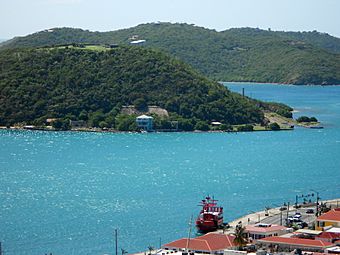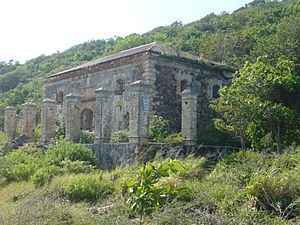Hassel Island, U.S. Virgin Islands facts for kids
|
Hassel Island Historic District
|
|
 |
|
| Nearest city | Charlotte Amalie |
|---|---|
| Area | 139 acres (56 ha) |
| Built | 1801 |
| Architect | Lt. Col. Charles Shipley |
| NRHP reference No. | 76001862 (original) 78003093 (increase) |
Quick facts for kids Significant dates |
|
| Added to NRHP | July 19, 1976 |
| Boundary increase | August 29, 1978 |
Hassel Island is a small island in the U.S. Virgin Islands. This is a United States territory located in the Caribbean Sea. Hassel Island is found in the Charlotte Amalie harbor. It lies just south of Saint Thomas and east of Water Island. It is part of the Water Island sub-district.
The island is about 136-acre (550,000 m2) in size. It was once connected to Saint Thomas as a peninsula. Back then, it was known as Orkanhullet, which means "Hurricane Hole." The Danish government separated Hassel Island from Saint Thomas in 1860. The island was named after the Hassel family, who owned a large part of the land. Today, there are fewer than five homes on the island. It is known as a quiet and private place.
Contents
Hassel Island's Rich History
Hassel Island has a long and interesting past. Maps from as early as 1687 show Careening Cove, a bay on the island.
Defending Charlotte Amalie Harbor
The Danish used Hassel Island's important location to protect the busy Charlotte Amalie harbor. This was during the 18th and 19th centuries.
The British took control of Hassel Island during the Napoleonic Wars. You can still see the ruins of several British buildings on the island. These include Fort Willoughby, built where Prince Frederik's Battery once stood. There are also Fort Shipley (Shipley's Battery) and Cowell's Battery. All three were built around 1802.
Early Marine Railway
In the 1840s, the St. Thomas Marine Railway Company built the St. Thomas Marine Railway Slip. This was later called the Creque Marine Railway. It is one of the first steam-powered marine railways in the Western Hemisphere. It might even be the oldest one still existing. The Boulton Company from Hamburg built the railway's steam engine.
In the 1860s, the Danish government dug a channel. This channel separated Hassel Island from Saint Thomas. It also helped improve the water flow in the Charlotte Amalie harbor.
The Royal Mail Steam Packet Company used Hassel Island as its main hub for the West Indies. This was from about 1850 until the 1870s. In 1871, the Hamburg America Line also set up a coaling station on the island. There was even a hospital for people with leprosy on the island.
The United States Army Corps of Engineers made the channel wider in 1919. This happened shortly after the United States bought the Danish West Indies. The United States Navy also built a naval station on the island. This station was used during World War I and World War II.
Modern History and Preservation
By the mid-1900s, most of Hassel Island was owned by the Paiewonsky family. They were a well-known local family. The Royal Mail Inn, a small hotel built by the Paiewonsky family, might be the hotel described in Herman Wouk's novel Don't Stop the Carnival.
The Creque Marine Railway and a signal station at Cowell's Battery were used until the 1960s and 1970s.
The southern part of the island was added to the National Register of Historic Places in 1976. This means it was recognized as an important historic area. In 1978, the historic district was made larger to include the rest of the island.
Also in 1978, the Virgin Islands National Park bought most of the island from the Paiewonsky family. The rest of the island is owned by the local government and a few private homes.
Since about 2004, several groups have been working to restore and protect the island's historic sites. These groups include the Saint Thomas and Hassel Island Preservation Trust and the Virgin Islands National Park. You can even take guided kayaking and hiking tours to explore the island's history.
Images for kids
See also
 In Spanish: Isla Hassel para niños
In Spanish: Isla Hassel para niños






